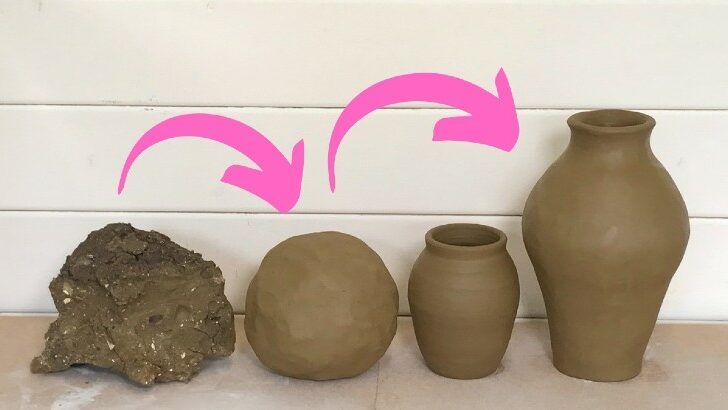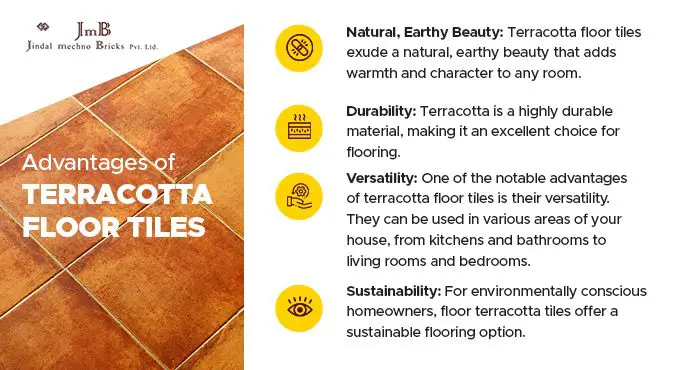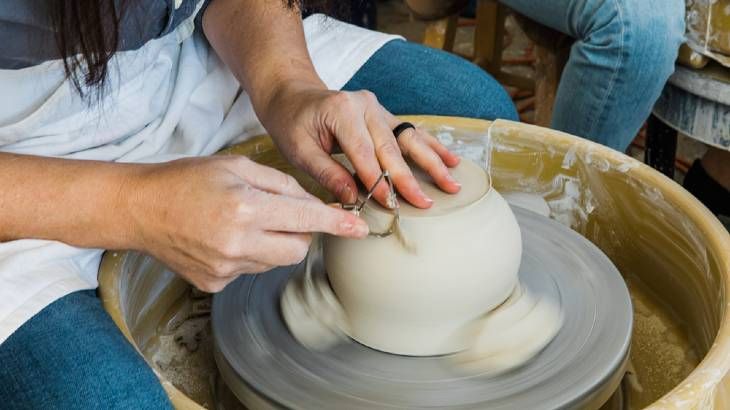Where Can I Find Wild Clay Near Me?
Introduction
Wild clay refers to clay that is collected from natural sources and has not been processed or refined for commercial sale. Potters, sculptors, and craftspeople are interested in sourcing local clays for their projects due to the natural variability and unique properties they impart. Collecting wild clay also allows artists to create work with materials reflective of their local environment. This guide will overview potential places where you can locate and harvest wild clay yourself.
Sources:
https://ceramicartsnetwork.org/ceramics-monthly/ceramics-monthly-article/wild-clay-and-glaze
Look for Exposed Riverbanks
One of the best places to find natural clay deposits is along rivers and streams. As the river erodes the soil, clay deposits are often exposed along the banks. Look for areas where the river has cut into the land, carving out sections of soil. The continual erosion gradually reveals the different layers of sediment, including clay beds deposited over time. Focus your search efforts along the outside curve of a meandering river, where erosion is accelerated. The steep cut banks here are ideal for spotting clay dug out by the river’s path.
Examine areas where the riverbank transitions from sandy soil to thick, sticky mud that is smooth to the touch. This change in sediment indicates you’ve reached a vein of clay. Scrape off some of the mud and roll it into a snake shape with your hands. If you can form a flexible snake that holds its shape without cracking, that’s a good sign you’ve struck clay. Just be sure to only take small amounts from the existing deposits so as not to contribute to further erosion of the riverbank.
You can also look for clay in smaller creeks, streams or seasonal drainages. However in some regions, flooding events or other geological processes may have deposited sand or rock layers on top of the clay beds. You’ll have to scrape and dig through the surface layers to find clay deposits hidden underneath along the creek banks.
According to the Definitive Guide by Ancientpottery.how, “Some of the best clay deposits are found along riverbanks.” The continual erosion helps expose fresh clay that can be harvested in a sustainable way.
Check Areas with Clay Soil
Certain soil types have higher clay content. Some of the most common types are clay, silty clay, sandy clay, clay loam, silty clay loam, sandy clay loam, loam, and silt. Look for areas with these soil types as they typically contain a higher percentage of clay than other soils like sand. One way to identify them is through soil maps which show the distribution of various soil types across a region. You can find detailed soil maps from the USDA Natural Resources Conservation Service or geological surveys in your state. Pay special attention to areas labeled as clay, silty clay, clay loam etc. as these will have the highest natural clay deposits.
Search Hillsides and Cliffs
One of the best places to find exposed clay deposits is on hillsides and cliffs. Look for areas where the soil has eroded, exposing layers of different materials. Sometimes you can spot seams of clay within these eroded areas.
The best time to check hillsides is after heavy rains, when water runoff has washed away vegetation and soil, revealing more of the underlying clay deposits. The weight and motion of the water helps expose clay that may otherwise be hidden below the surface. Focus your search on areas with steep inclines or bluffs (Source: https://ancientpottery.how/where-is-clay-found/).
Look for gray, white, red or yellow seams along eroded hillsides. Clay can appear in thick deposits or thin streaks within the soil. Check closely for any moist, malleable clay that you can dig out. Having a small shovel and bags on hand will allow you to easily collect any clay you find.
In addition to hillsides, also check the base of cliffs for deposits of clay that have eroded and fallen. Look for moist clay deposits in shaded areas protected from direct sun. With some persistence, you may be able to find ample wild clay deposits for pottery or other projects (Source: https://ancientpottery.how/how-to-find-clay/).
Dig Near Construction Sites
Building projects like housing developments, road work, and commercial construction often require a lot of digging and excavation. This digging can expose veins of clay that may be suitable for harvesting. Check for areas where soil has been moved around and dug out, as the exposed sublayers may contain clay deposits.
Before digging on any active or recent construction sites, be sure to get permission from the project foreman or property owner. Explain that you are looking to collect clay samples and promise to fill in any holes you dig. Construction crews are often on tight schedules and won’t appreciate someone poking around their job site unannounced.
With permission granted, look for areas where soil has been excavated and the subsurface layers are visible. See if you spot any gray, brown, red, or yellow clay. You may need to dig test holes yourself to find pockets of clay beneath the topsoil. Just be sure to refill the holes afterwards and avoid interfering with actual construction activities.
Recent housing developments with many excavated basements are ideal places to look for exposed clay. Commercial sites where foundation work is underway also tend to dig deep enough to potentially reveal clay deposits. Road construction projects are another option, as crews frequently cut into the subsurface layers to flatten and shape the ground for paving.
In most cases, clay found at construction sites will be suitable for crafting and pottery. But be sure to test samples first before collecting large amounts, as construction clay may also contain contaminants or debris mixed in.
Investigate Ponds and Lakes
One good place to look for natural clay deposits is in ponds and lakes. Over time, sediment carried by water often settles out and collects at the bottom of ponds and lakes. These sediment deposits may contain clay particles that have washed in from surrounding areas. Focus your search on shorelines and shallow areas, where sediment is most likely to accumulate. Use a shovel, hand trowel, or soil sampler to extract samples from various spots, then check for clay content. According to Where is Clay Found?, clays commonly form in low energy environments like lakes and seas as finer particles settle out of suspension in quiet water.
Look in Quarries and Mines
Quarries and mines that are actively cutting into the earth can be excellent places to find exposed clay deposits. As these operations remove soil and rock, they may reveal clay seams underneath. According to Wikipedia, “A clay pit is a quarry or mine for the extraction of clay, which is generally used for manufacturing pottery, bricks or Portland cement.” (source).
Areas with a history of quarrying for clay, shale, or other sedimentary deposits are especially promising to investigate. For example, a geological survey map of Michigan shows extensive clay mining in the central and southeastern parts of the state (source). Active quarry operations may continue to expose new clay deposits as they expand.
Before visiting a quarry or mine, call ahead and ask for permission to access the site. Explain that you are looking for clay deposits to use for pottery or other arts. The operators may be willing to allow you in or even point you toward areas where clay has been found.
Check With Local Potters
One of the best ways to find wild sources of clay is to ask local potters where they get their clay from. Potters who make hand-thrown or hand-built pottery often need large amounts of clay, so they frequently dig their own or know of places in the area to source quality clay.
Joining a local pottery guild or cooperative can be a great way to find clay sources, as experienced potters there will have wisdom to share. Attend a guild meeting and pose the question to the group – chances are someone will have a hot tip on where you can dig! Many potters are happy to divulge their clay sources, especially to beginners looking to get into the craft.
You can also visit pottery studios in your area and chat with potters there. Let them know you’re searching for wild clay deposits suitable for making pottery. They may allow you to tag along on their next clay sourcing expedition if you’re lucky!
Research Geological Surveys
Geological surveys can be a great resource for locating clay deposits in your area. The US Geological Survey provides mineral resource maps that show the locations of clay and shale deposits across the United States. These maps highlight major clay-producing regions and detail the types of clay found there.
You can order a report specific to your area from the USGS or your state’s geological survey. The report will outline the geology of your region and note any clay or shale deposits identified by surveyors. With this information, you’ll have a good starting point for where to search for wild clay locally.
Testing and Preparing Clay
Once you have sourced some promising clay specimens, it’s important to test them to confirm the clay quality and mineral content before using them for pottery or other projects.
One of the easiest at-home tests is the “vinegar test.” Simply drip some vinegar onto a lump of clay and observe the reaction. If the clay fizzes or bubbles, that indicates the presence of calcium carbonate which can weaken clay bodies. Non-reactive clays are preferred. For a more precise test, send a sample to a professional lab for full mineral analysis (Source).
To prepare wild clay for use:

- Break up large lumps and remove any rocks, roots or debris
- Soak the clay in water to create a slurry. Agitate and pour off excess water to remove sand and silt impurities
- Screen the clay slurry through a fine mesh to filter out remaining particles
- Allow the clay to settle out of the water and then decant off the excess water
- Press the clay into blocks and allow it to air dry fully before use
Proper processing is crucial for obtaining a smooth plastic clay ready for throwing, handbuilding, or other clay projects. It takes time and effort, but the reward is high quality homemade clay at no cost.





